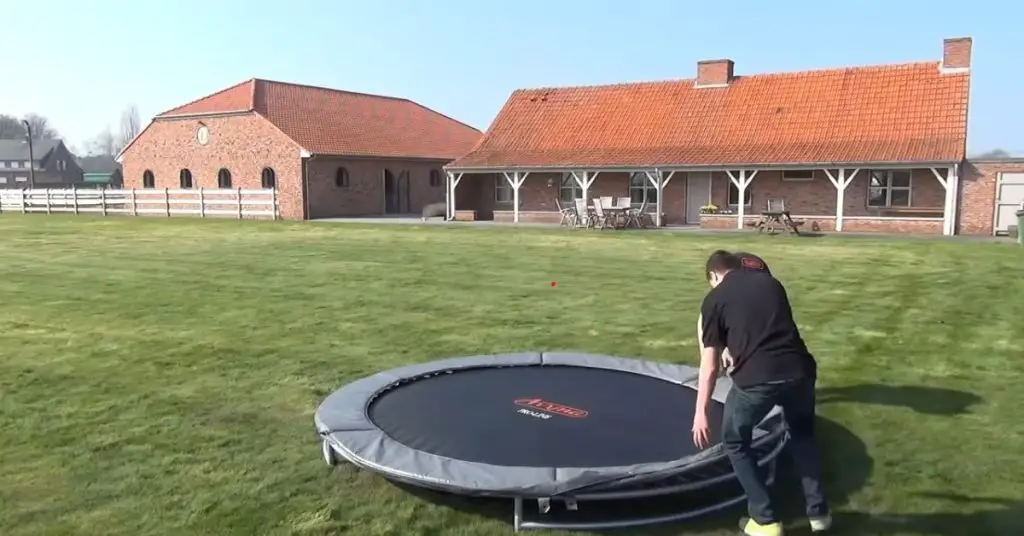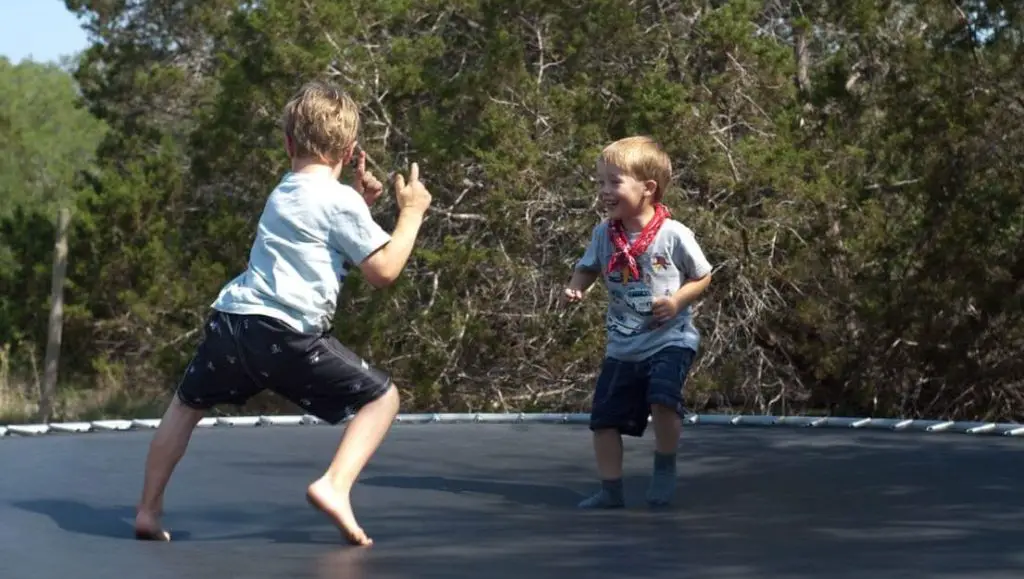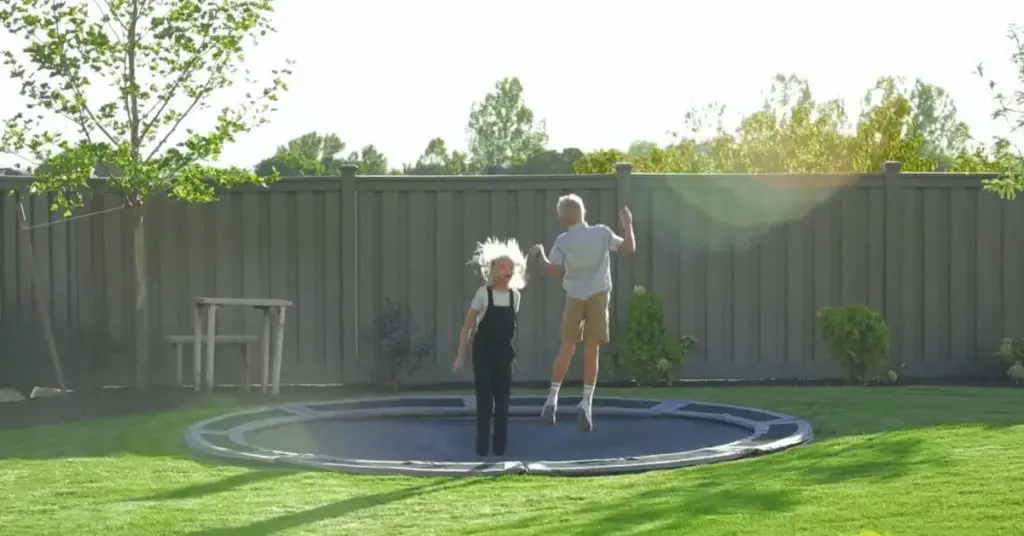From my perspective, are inground trampolines a safer option? With their installation below ground level, they inherently reduce the risk of falls and injuries. The absence of elevated edges eliminates the potential for accidents related to falling off the trampoline.
The lower height from the ground provides a safer jumping experience. Additionally, the soft landing surface surrounding the trampoline adds an extra layer of cushioning, reducing the impact on joints and bones.
Proper installation, reinforcement, and the addition of safety enclosures further enhance the safety measures. While user behavior and following safety guidelines are crucial, inground trampolines offer inherent safety advantages that contribute to a more secure trampoline experience for users of all ages.
Are Inground Trampolines Safer: Yes, inground trampolines are generally considered safer due to their reduced height from the ground, absence of elevated edges, and ability to create a soft landing surface around the trampoline.
Are Inground Trampolines Safer?

Inground trampolines are trampolines that are installed at ground level, with the jumping mat positioned either flush or slightly above the ground. They are designed to seamlessly integrate into the overall landscape, offering a visually appealing and integrated look.
These trampolines are typically surrounded by a soft landing surface, such as grass or specialized impact-absorbing materials, to provide an additional layer of safety and cushioning.
The inground installation not only enhances the aesthetics of the outdoor space but also offers accessibility and ease of use, eliminating the need for climbing or ladder access.
Inground trampolines offer a unique and visually appealing way to enjoy trampolining while maintaining the natural beauty of the surroundings.
What does the term “in-ground trampoline” refer to?
An in-ground trampoline is a special type of trampoline that is installed into the ground instead of being raised on legs. It is like a sunken trampoline, where the jumping surface is at ground level, and the main structure is underground.
This design eliminates the need for a ladder to get on the trampoline and does not require a safety enclosure, though you can still add one for extra safety if you prefer. For example, the Capital Play in-ground trampoline available on Amazon is designed this way.
If you like the idea of having an enclosure, you can also check out the BERG Trampoline Champion Sport on Amazon, which offers the option to purchase it with or without a matching enclosure.
Benefits of Inground Trampolines
Here are some benefits of an inground trampoline:
Aesthetics and Visual Appeal:
Inground trampolines blend seamlessly with the surrounding environment, offering a visually appealing and integrated look. They can be customized to match the outdoor space’s design and aesthetics, with options for different materials and colors.
This ensures that the trampoline becomes a visually pleasing addition to the landscape, enhancing the overall appeal while providing a safe and enjoyable jumping experience.
Accessibility and Ease of Use:
Inground trampolines offer easy accessibility, particularly for younger children or individuals with mobility challenges, as they eliminate the need for climbing or using ladders to access the trampoline.
With their ground-level placement, users can simply step onto the trampoline surface, making it more convenient and safer for individuals who may have difficulty with climbing or using traditional trampoline access methods.
Enhanced Safety Features:

Inground trampolines are widely regarded as safer options for several reasons. Firstly, their lower height from the ground significantly reduces the risk of falls and injuries compared to above-ground trampolines.
Secondly, the absence of elevated edges eliminates the potential for users to accidentally fall off the trampoline during use. Lastly, the soft landing surface surrounding the trampoline acts as a protective layer, cushioning falls and minimizing the impact on joints and bones.
Altogether, these safety features make inground trampolines a preferred choice for those seeking a safer trampolining experience with reduced risks of accidents and injuries.
By combining aesthetics, accessibility, and enhanced safety features, inground trampolines offer a compelling choice for individuals seeking a safer and visually appealing trampoline experience.
Safety Considerations of Inground Trampolines
Here are some safety considerations for inground trampolines:
Lower Risk of Falls and Injuries:
- Reduced height from the ground: Inground trampolines are installed at ground level or slightly elevated, minimizing the risk of falls from significant heights.
- Absence of elevated edges: Unlike above-ground trampolines, inground trampolines lack elevated edges, reducing the chances of users accidentally falling off.
- Soft landing surface: The surrounding area of an inground trampoline is typically equipped with a soft and impact-absorbing material, providing a safer landing surface and minimizing the risk of injuries.
Secure Installation and Structural Integrity:

- Proper site preparation and leveling: Before installation, careful site preparation ensures a level and stable ground, reducing the risk of the trampoline tilting or shifting during use.
- Reinforcement and anchoring techniques: Inground trampolines are installed with additional reinforcement and anchoring methods to enhance structural stability and prevent movement or tipping over, even during vigorous jumping sessions.
Protective Measures and Accessories:
- Safety enclosures and nets: Inground trampolines can be equipped with safety enclosures and nets to create a physical barrier that prevents users from accidentally bouncing off the trampoline.
- Padding and shock-absorbing materials: The frame and springs of inground trampolines can be covered with padding to minimize the risk of impact injuries.
- Weather covers and maintenance guidelines: Weather covers protect the trampoline from harsh elements while following maintenance guidelines ensure the trampoline remains in good condition, minimizing potential hazards.
Overall, inground trampolines provide safety advantages through their design, installation techniques, and the availability of protective measures and accessories. These considerations contribute to a safer trampolining experience for users of all ages.
Precautions and Maintenance Tips
Here are some precautions and maintenance tips:
Setting Age and Weight Limits:
To ensure safe and appropriate usage of your inground trampoline, it is important to establish and communicate age and weight restrictions. Consider the physical capabilities and coordination of potential users when determining these limits.
Follow the manufacturer’s guidelines regarding the maximum weight capacity to prevent excessive stress on the trampoline and maintain its structural integrity.
Supervision and Responsible Usage:
Always provide adequate supervision, especially when children are using the inground trampoline. Keep a close eye on their activities to ensure they are following safety guidelines.
Educate all users, regardless of age, about safe jumping techniques, such as bouncing in the center of the trampoline and avoiding dangerous stunts or flips. Discourage rough play and overcrowding on the trampoline to minimize the risk of collisions and accidents.
Regular Inspections and Maintenance Routines:
Perform regular inspections of the inground trampoline to identify any signs of wear and tear. Check for torn padding, loose springs, or damaged frames. If you notice any issues, address them promptly.
Tighten bolts, replace worn-out parts, and ensure proper alignment of the trampoline components to maintain their structural stability. By conducting routine maintenance tasks, you can prevent accidents and extend the lifespan of your trampoline.
Weather-Related Precautions:
Take weather-related precautions to protect your inground trampoline. Ensure it has sufficient wind resistance by securely anchoring it to the ground using appropriate anchoring systems.
If your trampoline comes with wind-resistant features, utilize them accordingly. Before use, remove any accumulated snow, ice, or excessive water from the trampoline’s surface.
This will help prevent slipping hazards and potential damage caused by the weight of the precipitation.
By diligently following these precautions and incorporating regular maintenance practices into your trampoline care routine, you can greatly enhance its safety and longevity.
Adhering to age and weight limits, promoting responsible usage, conducting thorough inspections, and implementing weather-related precautions will contribute to a safer and more enjoyable trampolining experience for all users.
Ensuring User Safety
Ensuring user safety is paramount when it comes to enjoying an inground trampoline. Educating users about proper jumping techniques, including bending the knees and using controlled movements, is essential.
Emphasizing the importance of jumping in the center of the trampoline to maintain balance and avoid contact with the frame or springs is crucial. It is important to discourage double bouncing, as it can lead to loss of control and increase the risk of accidents.
Teaching beginners and children about trampoline safety involves providing clear instructions for entering and exiting the trampoline, demonstrating basic jumps and movements, and promoting awareness of other users to avoid collisions.
Implementing safety accessories such as enclosures, padding, non-slip socks or appropriate footwear further enhances user safety. Regular reminders and guidelines displayed near the trampoline area reinforce responsible usage and discourage risky behaviors.
By incorporating these measures, a safer trampolining experience can be ensured for all users.
Comparing Inground and Traditional Trampolines
| Aspect | Inground Trampolines | Traditional Trampolines |
|---|---|---|
| Installation | Requires digging a pit in the ground and more effort to set up | Easier assembly with raised legs, can be more portable |
| Aesthetics | Blends seamlessly with the landscape, providing a cleaner look | Visible legs and frame may impact yard aesthetics |
| Accessibility | A permanent fixture in the yard | Requires climbing a ladder to get on and off |
| Safety Enclosure | Optional to include a safety enclosure for added protection | Often comes with a safety enclosure for standard safety measures |
| Portability | Tends to have a higher upfront cost due to the installation | Can be easily assembled and disassembled for portability |
| Space Utilization | Efficient use of yard space as it’s sunken into the ground | Occupies space above the ground, potentially limiting other activities |
| Weather Resistance | Generally more durable due to being partially underground | May require additional weatherproofing measures |
| Cost | The potential risk of falling from a raised height | Generally more affordable upfront cost |
| Maintenance | Requires occasional cleaning of the pit area and checking for debris | Regular maintenance of the frame, springs, and enclosure |
| Safety Concerns | Easier assembly with raised legs can be more portable | Potential risk of falling from a raised height |
Emergency Preparedness
Ensuring preparedness for potential emergencies is crucial when using an inground trampoline. Having individuals with first aid knowledge present is essential, as they can provide immediate assistance in the event of minor injuries such as sprains or strains.
It is important to have a well-stocked first aid kit readily available nearby, equipped with essential items for treating injuries. Additionally, keeping emergency contact information easily accessible is vital. This includes local medical services and poison control.
In the case of more severe injuries or accidents, such as head injuries or broken bones, it is imperative to call emergency services immediately and follow their instructions.
Prompt action and the ability to handle injuries effectively can greatly contribute to ensuring the safety and well-being of all trampoline users.
FAQs:
Q1: Are inground trampolines safer than above-ground trampolines?
Yes, inground trampolines are generally considered safer. Their lower height from the ground, absence of elevated edges, and soft landing surface contribute to a reduced risk of falls and injuries.
Q2: Can anyone use an inground trampoline?
While inground trampolines are suitable for most individuals, it is important to set age and weight limits for safe usage. Follow the manufacturer’s guidelines and ensure users are physically capable of jumping safely.
Q3: Do inground trampolines require less maintenance?
Inground trampolines still require regular maintenance, including inspections for wear and tear, tightening bolts, and replacing damaged parts. However, their design may simplify maintenance compared to above-ground trampolines.
Q4: Are safety enclosures necessary for inground trampolines?
While inground trampolines have inherent safety advantages, using safety enclosures or nets is still recommended. They provide an extra layer of protection, preventing users from accidentally bouncing off the trampoline.
Q5: Can an inground trampoline withstand harsh weather conditions?
Inground trampolines are designed to withstand various weather conditions, but precautions should be taken. Secure the trampoline during strong winds and remove snow or excessive water from the surface to prevent slipping hazards.
Q6: Are inground trampolines suitable for small yards?
Inground trampolines can be a great option for small yards, as they can be integrated into the landscape and take up less visual space compared to above-ground trampolines.
Q7: How long does an inground trampoline typically last?
The lifespan of an inground trampoline depends on various factors such as the quality of materials used, level of maintenance, and usage. With proper care and maintenance, inground trampolines can last for many years.
Conclusion:
In conclusion, inground trampolines are generally considered safer due to their design features that reduce the risk of falls and injuries. The lower height from the ground, the absence of elevated edges, and the presence of a soft landing surface all contribute to enhanced safety.
However, it’s important to note that safety is not solely reliant on the type of trampoline, but also on responsible usage, adherence to guidelines, and proper maintenance. Setting age and weight limits, supervising users, and educating them about safe jumping techniques are essential.
Implementing safety accessories like enclosures and padding further enhances safety. Regular inspections, maintenance routines, and weather-related precautions are necessary to ensure the trampoline’s longevity and safety standards.
While inground trampolines provide inherent safety advantages, it is crucial to prioritize responsible usage, supervision, and adherence to safety guidelines to fully enjoy the safer trampolining experience they offer.
We hope you will be well aware of are inground trampolines safer, after reading this comprehensive article. If you have any questions, feel free to comment below!

